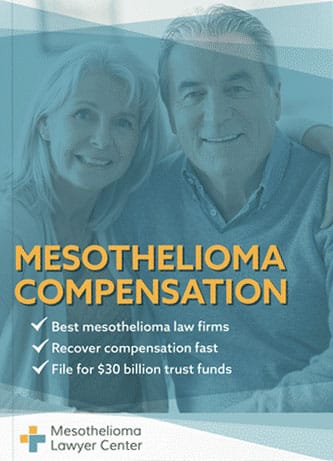Georgia-Pacific is most well-known for its paper products, but it also makes building and construction products, chemicals, mining products, and aerospace products. Many of Georgia-Pacific’s past products, especially Bestwall products, contained asbestos. The company now faces thousands of asbestos lawsuits.


FREE Financial Compensation Packet
- Info on law firms that will recover your HIGHEST COMPENSATION
- Learn how to get paid in 90 days
- File for your share of $30 billion in trust funds
Did Georgia-Pacific Use Asbestos?
Georgia-Pacific’s connection to asbestos comes from the acquisition of Bestwall Gypsum. Bestwall made construction materials with asbestos for many years, even after Georgia-Pacific bought the company.
Georgia-Pacific History
The history of paper giant Georgia-Pacific dates back to 1927. Founder Owen Robertson Cheatham began the company as the Georgia Hardwood Lumber Company in Augusta. The hardwood lumber wholesale company also opened and operated sawmills.
- In the 1940s, the company supplied more lumber to the war effort than any other company. After the war, it expanded westward, opening a facility in Bellingham, Washington.
- In 1948, the company’s name changed to Georgia-Pacific Plywood and Lumber Company, shortened to Georgia-Pacific Corporation in 1956.
- In 1957, Georgia-Pacific entered the paper and pulp manufacturing industry with its first pulp and liner board mill opening in Toledo, Oregon. In 1963, the company made its first tissues with the Coronet brand.
- Over the next several decades, Georgia-Pacific continued to grow and acquire more businesses along the way, including Bestwall Gypsum in 1965. Bestwall products contained asbestos until the 1980s.
- In 2005, Koch Industries bought Georgia-Pacific Corporation for $21 billion. It remains operational as a subsidiary of Koch.
What Georgia-Pacific Products Contained Asbestos?
Georgia-Pacific has been held liable for asbestos exposure due primarily to Bestwall Gypsum products. It acquired the company in the 1960s and continued to use asbestos in Bestwall products through the 1970s.
Bestwall Gypsum made drywall and the first-ever gypsum wallboard, called Beaver Products’ Bestwall. It was a popular building material used beginning in the late 1920s and throughout the 1940s.
When Georgia-Pacific bought Bestwall, it continued manufacturing asbestos-containing products. This was around the time when companies were learning that asbestos was causing health problems in workers, although research about the harmful asbestos dates back centuries before then.
Gypsum is not harmful, but the Bestwall products included asbestos fibers. These were mixed into the gypsum to add strength, insulation, and fireproofing.
Some of the Bestwall/Georgia-Pacific products that contained asbestos include:
- Acoustical plaster
- Bedding compound
- Ceiling texture
- Central mix
- Drywall
- Drywall adhesive
- Joint compound
- Kalite
- Laminating compound
- Roof coating
- Spackling compound
- Topping compound
- Wallboard joint compound
Who Was at Risk of Asbestos Exposure From Georgia-Pacific?
The use of asbestos in these gypsum products provided useful qualities for building materials but also put many people at risk of serious health problems. Asbestos fibers can be easily inhaled or ingested when released into the air.
Once in the body, the fibers become lodged in tissues and cause damage that, over many years, can lead to the development of lung cancer, mesothelioma, a rare type of cancer, and asbestosis, a progressive scarring of lung tissue.
Many workers were exposed to asbestos because of Bestwall and Georgia-Pacific products. Workers who manufactured the materials worked directly with asbestos, mixing it with gypsum.
Before the dangers were known, these workers lacked protective safety gear. They were at serious risk of inhaling the fibers and bringing them home on their clothing to contaminate family members.
Another group at risk is construction workers. This is a much bigger group because it includes anyone who worked with or around the asbestos products made by Bestwall and Georgia-Pacific.
The group also includes drywall workers who worked directly with the products, but also all other types of workers on building construction sites:
- Laborers
- Carpenters
- Electricians
- Plumbers
- HVAC workers
One particular hazard was that these workers sanded the dried joint compound, causing asbestos fibers to become airborne. This activity put anyone working in the area at risk of inhaling the fibers.
Anyone who did renovation or remodeling work on an older home that contains these asbestos materials is also at risk of developing mesothelioma.
Georgia-Pacific Asbestos Lawsuits
Georgia-Pacific has been fighting asbestos lawsuits for years. People exposed who later got sick have sued the company for damages.
For example, a Florida man who sued the company ended in a jury award of $9.4 million to the victim.
As a construction worker, Ron Taylor worked as a painting supervisor in the 1970s. He worked with Georgia-Pacific and Bestwall joint compound.
Taylor described being covered in dust most days from the sanding down of the joint compound. He was ultimately diagnosed with mesothelioma.
Taylor sought $29 million but was awarded $9.4 million by the jury, which found that he was partly liable and that Georgia-Pacific was primarily liable for his illness.
Georgia-Pacific Fraudulent Asbestos Research
Facing thousands of lawsuits and claims, Georgia-Pacific conducted a secret, fraudulent research program hoping to prove that its products did not cause cancer, according to reports.
The company hired experts to conduct the studies and publish the desired evidence. Ultimately, 18 scientists were paid over $6 million to do this work.
A New York appeals court determined that this practice would likely result in fraud. The study results were likely to be manipulated to help Georgia-Pacific limit its liability.
Georgia-Pacific Asbestos Bankruptcy Controversy
Georgia-Pacific has continued to face controversy over how it has handled asbestos claims. As part of Koch Industries, the company has tried to dodge liability by performing the Texas Two-Step legal maneuver.
This involves spinning off a subsidiary to hold the company’s asbestos liabilities. That subsidiary then files for bankruptcy, halting all lawsuits against the parent company. It is controversial because it delays and limits the ability of asbestos illness victims to get the compensation they need for medical bills.
In 2023, asbestos victims and their lawyers tried to halt the Georgia-Pacific subsidiary’s bankruptcy so that they could continue their lawsuits. A court ruled in June that the stay on lawsuits could continue as Georgia-Pacific proceeds with the bankruptcy process.
How to Seek Compensation if You Were Exposed to Georgia-Pacific Asbestos
If you worked with Georgia-Pacific or Bestwall asbestos products, you can rely on an experienced and compassionate mesothelioma lawyer to help you file a lawsuit and seek compensation.
Lawsuits against Georgia-Pacific are currently paused, but there may be other ways to recover damages. A lawyer can review your work history and find all the companies potentially liable for your illness. You could be eligible for asbestos trust fund claims or lawsuits against other companies.
Legal Help
If you’ve been injured by mesothelioma, asbestos-related lung cancer, or asbestosis, keep in mind that there is a good chance that you’ll qualify for considerable compensation. Don’t forget to fill out our form to get our free Financial Compensation Packet, filled with information on the experienced asbestos and mesothelioma attorneys in your area.

Paul Danziger
Reviewer and EditorPaul Danziger grew up in Houston, Texas and earned a law degree from Northwestern University School of Law in Chicago. For over 25 years years he has focused on representing mesothelioma cancer victims and others hurt by asbestos exposure. Paul and his law firm have represented thousands of people diagnosed with mesothelioma, asbestosis, and lung cancer, recovering significant compensation for injured clients. Every client is extremely important to Paul and he will take every call from clients who want to speak with him. Paul and his law firm handle mesothelioma cases throughout the United States.
References
- Georgia-Pacific. (n.d.). Georgia-Pacific History.
Retrieved from: https://www.gp.com/about-us/history - Lowrey, B. (2015, August 13). Georgia-Pacific Hit With $9.4M Jury Verdict in Asbestos Trial. Law360.
Retrieved from: https://www.law360.com/articles/690999/georgia-pacific-hit-with-9-4m-jury-verdict-in-asbestos-trial - Morris, J. (2013, October 21). Facing Lawsuits Over Deadly Asbestos, Paper Giant Launched Secretive Research Program. The Center for Public Integrity.
Retrieved from: https://www.publicintegrity.org/2013/10/21/13559/facing-lawsuits-over-deadly-asbestos-paper-giant-launched-secretive-research - Union of Concerned Scientists. (2017, October 10). How Georgia-Pacific Knowingly Published Fake Science on the Safety of Asbestos.
Retrieved from: https://www.ucsusa.org/resources/how-georgia-pacific-knowingly-published-fake-science-safety-asbestos - Knauth, D. (2023, February 17). Cancer Patient Asks Court to End Georgia-Pacific Asbesetos Bankruptcy. Reuters.
Retrieved from: https://www.reuters.com/article/georgia-pacific-court/cancer-patient-asks-court-to-end-georgia-pacific-asbestos-bankruptcy-idUSL1N34X2N0 - Knauth, D. (2023, June 20). Georgia-Pacific May Maintain Bankruptcy Pause on Lawsuits, Court Rules. Reuters.
Retrieved from: https://www.reuters.com/legal/georgia-pacific-may-maintain-bankruptcy-pause-lawsuits-court-rules-2023-06-20/
